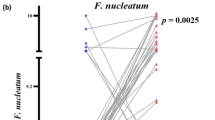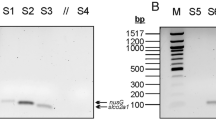Abstract
Commensal bacteria in the colon may play a role in colorectal cancer (CRC) development. Recent studies from North America showed that Fusobacterium nucleatum (Fn) infection is over-represented in disease tissue versus matched normal tissue in CRC patients. Using quantitative real-time polymerase chain reaction (qPCR) of DNA extracted from colorectal tissue biopsies and surgical resections of three European cohorts totalling 122 CRC patients, we found an over-abundance of Fn in cancerous compared to matched normal tissue (p < 0.0001). To determine whether Fn infection is an early event in CRC development, we assayed Fn in colorectal adenoma (CRA) tissue from 52 Irish patients. While for all CRAs the Fn level was not statistically significantly higher in disease versus normal tissue (p = 0.06), it was significantly higher for high-grade dysplasia (p = 0.015). As a secondary objective, we determined that CRC patients with low Fn levels had a significantly longer overall survival time than patients with moderate and high levels of the bacterium (p = 0.008). The investigation of Fn as a potential non-invasive biomarker for CRC screening showed that, while Fn was more abundant in stool samples from CRC patients compared to adenomas or controls, the levels in stool did not correlate with cancer or adenoma tissue levels from the same individuals. This is the first study examining Fn in the colonic tissue and stool of European CRC and CRA patients, and suggests Fn as a novel risk factor for disease progression from adenoma to cancer, possibly affecting patient survival outcomes. Our results highlight the potential of Fn detection as a diagnostic and prognostic determinant in CRC patients.




Similar content being viewed by others
References
Kamangar F, Dores GM, Anderson WF (2006) Patterns of cancer incidence, mortality, and prevalence across five continents: defining priorities to reduce cancer disparities in different geographic regions of the world. J Clin Oncol 24(14):2137–2150. doi:10.1200/JCO.2005.05.2308
Ferlay J, Shin HR, Bray F, Forman D, Mathers C, Parkin DM (2010) Estimates of worldwide burden of cancer in 2008: GLOBOCAN 2008. Int J Cancer 127(12):2893–2917. doi:10.1002/ijc.25516
Winawer SJ, Zauber AG (2002) The advanced adenoma as the primary target of screening. Gastrointest Endosc Clin N Am 12(1):1–9, v
Kau AL, Ahern PP, Griffin NW, Goodman AL, Gordon JI (2011) Human nutrition, the gut microbiome and the immune system. Nature 474(7351):327–336. doi:10.1038/nature10213
Vipperla K, O’Keefe SJ (2012) The microbiota and its metabolites in colonic mucosal health and cancer risk. Nutr Clin Pract 27(5):624–635. doi:10.1177/0884533612452012
Lepage P, Leclerc MC, Joossens M, Mondot S, Blottière HM, Raes J, Ehrlich D, Doré J (2013) A metagenomic insight into our gut’s microbiome. Gut 62(1):146–158. doi:10.1136/gutjnl-2011-301805
Sokol H, Seksik P, Furet JP, Firmesse O, Nion-Larmurier I, Beaugerie L, Cosnes J, Corthier G, Marteau P, Doré J (2009) Low counts of Faecalibacterium prausnitzii in colitis microbiota. Inflamm Bowel Dis 15(8):1183–1189. doi:10.1002/ibd.20903
Kassinen A, Krogius-Kurikka L, Mäkivuokko H, Rinttilä T, Paulin L, Corander J, Malinen E, Apajalahti J, Palva A (2007) The fecal microbiota of irritable bowel syndrome patients differs significantly from that of healthy subjects. Gastroenterology 133(1):24–33. doi:10.1053/j.gastro.2007.04.005
Malinen E, Rinttilä T, Kajander K, Mättö J, Kassinen A, Krogius L, Saarela M, Korpela R, Palva A (2005) Analysis of the fecal microbiota of irritable bowel syndrome patients and healthy controls with real-time PCR. Am J Gastroenterol 100(2):373–382. doi:10.1111/j.1572-0241.2005.40312.x
Nyangale EP, Mottram DS, Gibson GR (2012) Gut microbial activity, implications for health and disease: the potential role of metabolite analysis. J Proteome Res 11(12):5573–5585. doi:10.1021/pr300637d
Marchesi JR, Dutilh BE, Hall N, Peters WH, Roelofs R, Boleij A, Tjalsma H (2011) Towards the human colorectal cancer microbiome. PLoS One 6(5):e20447. doi:10.1371/journal.pone.0020447
Arthur JC, Perez-Chanona E, Mühlbauer M, Tomkovich S, Uronis JM, Fan TJ, Campbell BJ, Abujamel T, Dogan B, Rogers AB, Rhodes JM, Stintzi A, Simpson KW, Hansen JJ, Keku TO, Fodor AA, Jobin C (2012) Intestinal inflammation targets cancer-inducing activity of the microbiota. Science 338(6103):120–123. doi:10.1126/science.1224820
Wang T, Cai G, Qiu Y, Fei N, Zhang M, Pang X, Jia W, Cai S, Zhao L (2012) Structural segregation of gut microbiota between colorectal cancer patients and healthy volunteers. ISME J 6(2):320–329. doi:10.1038/ismej.2011.109
Meucci G, Tatarella M, Vecchi M, Ranzi ML, Biguzzi E, Beccari G, Clerici E, de Franchis R (1997) High prevalence of Helicobacter pylori infection in patients with colonic adenomas and carcinomas. J Clin Gastroenterol 25(4):605–607
Swidsinski A, Khilkin M, Kerjaschki D, Schreiber S, Ortner M, Weber J, Lochs H (1998) Association between intraepithelial Escherichia coli and colorectal cancer. Gastroenterology 115(2):281–286
Konstantinov SR, Kuipers EJ, Peppelenbosch MP (2013) Functional genomic analyses of the gut microbiota for CRC screening. Nat Rev Gastroenterol Hepatol 10(12):741–745. doi:10.1038/nrgastro.2013.178
Scanlan PD, Shanahan F, Clune Y, Collins JK, O’Sullivan GC, O’Riordan M, Holmes E, Wang Y, Marchesi JR (2008) Culture-independent analysis of the gut microbiota in colorectal cancer and polyposis. Environ Microbiol 10(3):789–798. doi:10.1111/j.1462-2920.2007.01503.x
Jobin C (2013) Colorectal cancer: looking for answers in the microbiota. Cancer Discov 3(4):384–387. doi:10.1158/2159-8290.CD-13-0042
Sobhani I, Amiot A, Le Baleur Y, Levy M, Auriault ML, Van Nhieu JT, Delchier JC (2013) Microbial dysbiosis and colon carcinogenesis: could colon cancer be considered a bacteria-related disease? Therap Adv Gastroenterol 6(3):215–229. doi:10.1177/1756283X12473674
Castellarin M, Warren RL, Freeman JD, Dreolini L, Krzywinski M, Strauss J, Barnes R, Watson P, Allen-Vercoe E, Moore RA, Holt RA (2012) Fusobacterium nucleatum infection is prevalent in human colorectal carcinoma. Genome Res 22(2):299–306. doi:10.1101/gr.126516.111
Kostic AD, Gevers D, Pedamallu CS, Michaud M, Duke F, Earl AM, Ojesina AI, Jung J, Bass AJ, Tabernero J, Baselga J, Liu C, Shivdasani RA, Ogino S, Birren BW, Huttenhower C, Garrett WS, Meyerson M (2012) Genomic analysis identifies association of Fusobacterium with colorectal carcinoma. Genome Res 22(2):292–298. doi:10.1101/gr.126573.111
Citron DM (2002) Update on the taxonomy and clinical aspects of the genus Fusobacterium. Clin Infect Dis 35(Suppl 1):S22–S27. doi:10.1086/341916
Moore WE, Moore LV (1994) The bacteria of periodontal diseases. Periodontol 2000 5:66–77
Swidsinski A, Dörffel Y, Loening-Baucke V, Tertychnyy A, Biche-Ool S, Stonogin S, Guo Y, Sun ND (2012) Mucosal invasion by fusobacteria is a common feature of acute appendicitis in Germany, Russia, and China. Saudi J Gastroenterol 18(1):55–58. doi:10.4103/1319-3767.91734
Roberts GL (2000) Fusobacterial infections: an underestimated threat. Br J Biomed Sci 57(2):156–162
Strauss J, Kaplan GG, Beck PL, Rioux K, Panaccione R, DeVinney R, Lynch T, Allen-Vercoe E (2011) Invasive potential of gut mucosa-derived Fusobacterium nucleatum positively correlates with IBD status of the host. Inflamm Bowel Dis 17(9):1971–1978. doi:10.1002/ibd.21606
Han YW, Shi W, Huang GT, Kinder Haake S, Park NH, Kuramitsu H, Genco RJ (2000) Interactions between periodontal bacteria and human oral epithelial cells: Fusobacterium nucleatum adheres to and invades epithelial cells. Infect Immun 68(6):3140–3146
Dharmani P, Strauss J, Ambrose C, Allen-Vercoe E, Chadee K (2011) Fusobacterium nucleatum infection of colonic cells stimulates MUC2 mucin and tumor necrosis factor alpha. Infect Immun 79(7):2597–2607. doi:10.1128/IAI.05118-11
McCoy AN, Araújo-Pérez F, Azcárate-Peril A, Yeh JJ, Sandler RS, Keku TO (2013) Fusobacterium is associated with colorectal adenomas. PLoS One 8(1):e53653. doi:10.1371/journal.pone.0053653
Kostic AD, Chun E, Robertson L, Glickman JN, Gallini CA, Michaud M, Clancy TE, Chung DC, Lochhead P, Hold GL, El-Omar EM, Brenner D, Fuchs CS, Meyerson M, Garrett WS (2013) Fusobacterium nucleatum potentiates intestinal tumorigenesis and modulates the tumor-immune microenvironment. Cell Host Microbe 14(2):207–215
Rubinstein MR, Wang X, Liu W, Hao Y, Cai G, Han YW (2013) Fusobacterium nucleatum promotes colorectal carcinogenesis by modulating E-cadherin/beta-catenin signaling via its FadA adhesin. Cell Host Microbe 14(2):195–206. doi:10.1016/j.chom.2013.07.012
Huber S, Gagliani N, Zenewicz LA, Huber FJ, Bosurgi L, Hu B, Hedl M, Zhang W, O’Connor W Jr, Murphy AJ, Valenzuela DM, Yancopoulos GD, Booth CJ, Cho JH, Ouyang W, Abraham C, Flavell RA (2012) IL-22BP is regulated by the inflammasome and modulates tumorigenesis in the intestine. Nature 491(7423):259–263. doi:10.1038/nature11535
Sharara AI, Abou Hamdan T, Malli A, El-Halabi MM, Hashash JG, Ghaith OA, Kanj SS (2013) Association of Streptococcus bovis endocarditis and advanced colorectal neoplasia: a case–control study. J Dig Dis 14(7):382–387. doi:10.1111/1751-2980.12059
Gentili V, Gianesini S, Balboni PG, Menegatti E, Rotola A, Zuolo M, Caselli E, Zamboni P, Di Luca D (2012) Panbacterial real-time PCR to evaluate bacterial burden in chronic wounds treated with Cutimed™ Sorbact™. Eur J Clin Microbiol Infect Dis 31(7):1523–1529. doi:10.1007/s10096-011-1473-x
Arumugam M, Raes J, Pelletier E, Le Paslier D, Yamada T, Mende DR, Fernandes GR, Tap J, Bruls T, Batto JM, Bertalan M, Borruel N, Casellas F, Fernandez L, Gautier L, Hansen T, Hattori M, Hayashi T, Kleerebezem M, Kurokawa K, Leclerc M, Levenez F, Manichanh C, Nielsen HB, Nielsen T, Pons N, Poulain J, Qin J, Sicheritz-Ponten T, Tims S, Torrents D, Ugarte E, Zoetendal EG, Wang J, Guarner F, Pedersen O, de Vos WM, Brunak S, Doré J; MetaHIT Consortium, Antolín M, Artiguenave F, Blottiere HM, Almeida M, Brechot C, Cara C, Chervaux C, Cultrone A, Delorme C, Denariaz G, Dervyn R, Foerstner KU, Friss C, van de Guchte M, Guedon E, Haimet F, Huber W, van Hylckama-Vlieg J, Jamet A, Juste C, Kaci G, Knol J, Lakhdari O, Layec S, Le Roux K, Maguin E, Mérieux A, Melo Minardi R, M’Rini C, Muller J, Oozeer R, Parkhill J, Renault P, Rescigno M, Sanchez N, Sunagawa S, Torrejon A, Turner K, Vandemeulebrouck G, Varela E, Winogradsky Y, Zeller G, Weissenbach J, Ehrlich SD, Bork P (2011) Enterotypes of the human gut microbiome. Nature 473(7346):174–180. doi:10.1038/nature09944
Terry MB, Neugut AI, Bostick RM, Sandler RS, Haile RW, Jacobson JS, Fenoglio-Preiser CM, Potter JD (2002) Risk factors for advanced colorectal adenomas: a pooled analysis. Cancer Epidemiol Biomarkers Prev 11(7):622–629
Hill MJ, Morson BC, Bussey HJ (1978) Aetiology of adenoma—carcinoma sequence in large bowel. Lancet 1(8058):245–247
Wu N, Yang X, Zhang R, Li J, Xiao X, Hu Y, Chen Y, Yang F, Lu N, Wang Z, Luan C, Liu Y, Wang B, Xiang C, Wang Y, Zhao F, Gao GF, Wang S, Li L, Zhang H, Zhu B (2013) Dysbiosis signature of fecal microbiota in colorectal cancer patients. Microb Ecol 66(2):462–470. doi:10.1007/s00248-013-0245-9
Zoetendal EG, von Wright A, Vilpponen-Salmela T, Ben-Amor K, Akkermans AD, de Vos WM (2002) Mucosa-associated bacteria in the human gastrointestinal tract are uniformly distributed along the colon and differ from the community recovered from feces. Appl Environ Microbiol 68(7):3401–3407
Peyret-Lacombe A, Brunel G, Watts M, Charveron M, Duplan H (2009) TLR2 sensing of F. nucleatum and S. sanguinis distinctly triggered gingival innate response. Cytokine 46(2):201–210. doi:10.1016/j.cyto.2009.01.006
Acknowledgements
Funding for the study was provided by the Health Research Board of Ireland (project grant nos. HRA_PHS/2011/3 to DJH and TRA/2007/26 to JHMP). The Czech component was supported by IGA grant nos. NT12025-4 and NT14329-3. We wish to thank Dr. Robert Holt and Dr. Mauro Castellarin (BC Cancer Research Centre, Vancouver, BC, V5Z 1 L3, Canada) for providing us with an aliquot of gDNA from the cultured Fn strain CC53 as a positive control for the qPCR assays and advice on the assay.
Conflict of interest
The authors declare that they have no conflict of interest.
Author information
Authors and Affiliations
Corresponding author
Electronic supplementary material
Below is the link to the electronic supplementary material.
ESM 1
(JPEG 505 kb)
Rights and permissions
About this article
Cite this article
Flanagan, L., Schmid, J., Ebert, M. et al. Fusobacterium nucleatum associates with stages of colorectal neoplasia development, colorectal cancer and disease outcome. Eur J Clin Microbiol Infect Dis 33, 1381–1390 (2014). https://doi.org/10.1007/s10096-014-2081-3
Received:
Accepted:
Published:
Issue Date:
DOI: https://doi.org/10.1007/s10096-014-2081-3




